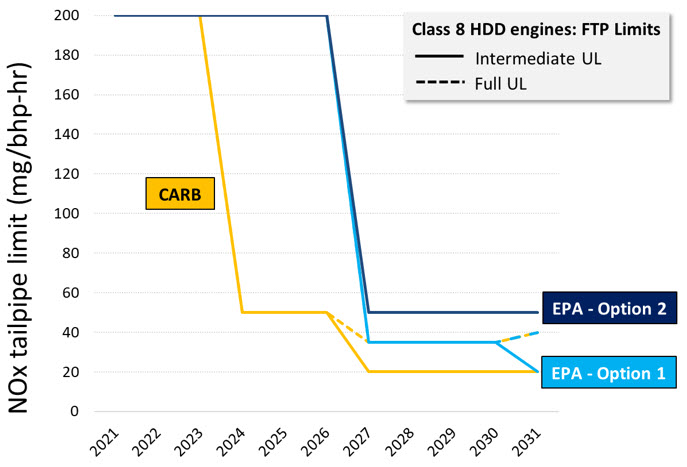EPA Proposal Summary : "Cleaner Trucks Plan"
On March 7th 2022, the US EPA announced the notice for proposed rulemaking for “Cleaner Trucks Plan”. Following on the heels of California’s HD Low NOx Omnibus rule, the EPA is setting stringent tailpipe standards to reduce NOx and greenhouse gas emissions from heavy-duty trucks and buses.
What are the changes expected?
First, note that this is a proposal and NOT a final rulemaking. The EPA has put forth two options for tailpipe NOx standards and we discuss Class 8 long-haul trucks here:
Option 1 (~ California standards after MY 2031):
NOx limit: MY2027–2030: 35 mg/mi, MY 2031: 20 mg/bhp-hr
Full Useful Life (FUL) : Increases to 600K mi in 2027 and 800,000 mi in 2031
(Note FUL is 435,000 miles today)
Option 2:
NOx limit: 50 mg/bhp-hr after MY2027 (note that this is a “flat” standard and does not involve a change for intermediate and full useful life or get more stricter after 2031)
FUL: Fixed at 650,000 mi
The figure shows a comparison of the tailpipe certification limits proposed by the EPA with the previously set CARB standards. Clearly, option 1 is the more stringent one and aligns with California starting model year 2031.

Other test changes
- New low-load cycle (LLC) introduced, similar to CARB to address low load and idling emissions
- Off-cycle testing : Similar to California’s 3-Bin MAW method
- HD spark ignited (SI) engines will require testing on SET lab cycle (previously only for CI engines)
Credit multipliers ?
- Credit multipliers will be given for early compliance, and credits given for hybrids (HEVs) / battery electrics (BEVs) / fuel cell electric vehicles (FCEVs)
- However no emission credit multipliers will be given for HEVs/BEVs/FCEVs. The idea is to not dilute the emission reductions benefit by allowing extra credit for zero tailpipe emitting vehicles.
Multi-pollutant rule
The EPA envisions this as a multi-pollutant rule, which sets standards for both criteria pollutants as well as GHGs concurrently.
Proposed is a targeted revision of GHG Phase 2 MY2027 – 2029 standards. This addresses the need to revise CO2 standards given the increased penetration of zero emitting vehicles in some vocational segments. GHG standards could be tightened for 17 of the 33 subcategories of vocational and tractor vehicles for model years 2027 – 2029.
GHG Phase 3 regulations will be set separately and will likely be set at levels to accelerate electrification.
Contact
For any inquiries please email
mobilitynotes@gmail.com
If you like such content, check out the monthly newsletter covering the latest on sustainable transportation technologies and regulations. Sign up below.
Like it ? Share it !
Other recent posts
SAE WCX 2024 – Year in Review
The SAE World Congress was held in Detroit and covered a broad range of topics pertinent to transport decarbonization. Here’s a link to download presentations on emissions and sustainability.
Real-world CO2 emissions from cars and vans in Europe are 20% higher than certification values
EU Commission finds real-world CO2 emissions from cars and vans in Europe greatly exceed lab certification values. Plug-in hybrids are not being charged as much as estimated.
US EPA MY 2027-2032 Heavy-Duty Phase 3 GHG Standards
The U.S. EPA has finalized the Phase 3 GHG rule specifying CO2 emission reductions from heavy-duty trucks and buses over MY 2027 – 2032.
